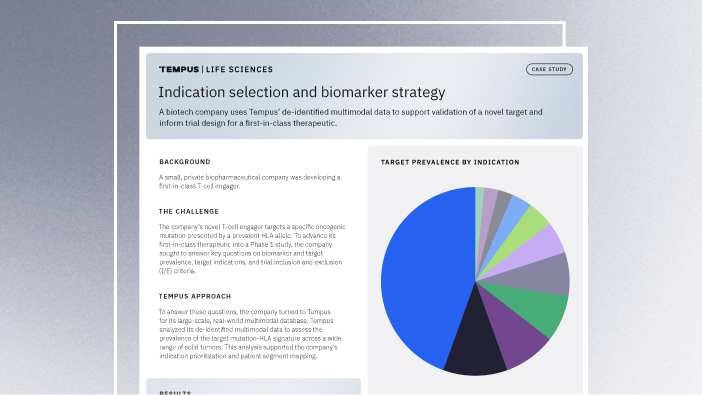-
PROVIDERS
New MRD Medicare Coverage for Select Indications*
*When coverage criteria are met. Additional criteria and exceptions for coverage may apply.
-
LIFE SCIENCES
ENROLL NOW
Tempus’ patient-derived organoid screens
Evaluate the efficacy of your preclinical compounds using fixed organoid panels designed for diverse therapeutic applications -
PATIENTS
It's About Time
View the Tempus vision.
- RESOURCES
-
ABOUT US
View Job Postings
We’re looking for people who can change the world.
- INVESTORS
07/23/2025
Q&A: How AI-driven solutions are helping close care gaps in precision medicine adoption
This article synthesizes the key questions and insights from their conversation, highlighting how AI-driven solutions can support providers, benefit patients, and help life sciences partners ensure their therapies reach the patients who need them most.
Speakers
Ryan Fukushima
Chief Operating Officer, Tempus

Dr. Gary Grad
Senior Medical Oncologist, Medical Science, Tempus

Ahmed ElNawawi
Head of the U.S. Commercial Organization at Menarini Stemline

Chief Operating Officer, Tempus
Dr. Gary Grad
Senior Medical Oncologist, Medical Science, Tempus
Ahmed ElNawawi
Head of the U.S. Commercial Organization at Menarini Stemline
The landscape of precision medicine is evolving at an unprecedented pace, bringing new hope to patients but also creating significant challenges for healthcare providers and life sciences companies. With treatment guidelines updating constantly, ensuring that every patient receives the right care at the right time has become increasingly complex.
To explore this challenge, Tempus recently hosted a webinar with leaders from across the healthcare ecosystem. The discussion featured Ryan Fukushima, Chief Operating Officer at Tempus; Dr. Gary Grad, a senior medical oncologist at Tempus; and Ahmed ElNawawi, Head of the U.S. Commercial Organization at Menarini Stemline. They discussed how artificial intelligence and real-time data are becoming essential tools to close care gaps, improve adherence to clinical guidelines, and create a new competitive edge for the life sciences industry.
This article synthesizes the key questions and insights from their conversation, highlighting how AI-driven solutions can support providers, benefit patients, and help life sciences partners ensure their therapies reach the patients who need them most.
Ryan Fukushima: How are AI-driven approaches changing the way we address care gaps compared to traditional methods? |
Dr. Gary Grad: The traditional way of keeping up with new treatments and biomarkers was hit-or-miss, relying on clinicians having time to read a journal article or attend a conference. We know there is a learning curve whenever a new therapy is approved and AI can shorten that curve by embedding critical information directly into the clinical workflow. It is important to remember that gaps in care are not always knowledge gaps; they can often be operational gaps within a health system. AI helps streamline the process and get the right information to physicians as soon as a therapy or biomarker becomes relevant.Ahmed ElNawawi: AI makes precision medicine more precise. In the past, commercial teams would share clinical and diagnostic information broadly and hope something would stick, with no real way to measure effectiveness. With AI and machine learning, we can be much more targeted. These tools can help identify health disparities, find geographic locations that may not be receiving the right care, and facilitate provider intervention. This empowers patients and their caregivers to get the best possible therapy. |
Ryan Fukushima: Clinician burnout is a major issue. How can these AI tools integrate into clinical workflows without adding to the administrative burden? |
Dr. Grad: The administrative burden is one of the hardest parts of an oncologist’s day. However, the biggest stressor is the fear of missing something. Amidst all the documentation and administrative tasks, doing the right thing for a patient is a clinician’s greatest concern. In this way, an AI tool integrated into the electronic health record (EHR) can act as a safety net. It can remind a provider if a recommended test was not ordered or if an action slipped through the cracks. We see this frequently in tumor boards, where a physician thought a test was ordered but it never happened. An integrated system can detect these gaps, regardless of the cause, and help make sure the appropriate action is taken. This relieves a tremendous amount of stress and helps providers focus on patient care. |
|
“One of the biggest burdens that leads to stress and burnout in physicians is the fear of actually missing something for the patient you’re taking care of. Having a tool that can serve as a safety net relieves a tremendous amount of stress.” – Dr. Gary Grad, Senior Medical Oncologist, Tempus |
Ryan Fukushima: Can you provide a real-world example of how closing a care gap creates a “triple win” for patients, providers, and the life sciences industry? |
Ahmed ElNawawi: This “triple win” can be thought of as benefiting three Ps: the patient, the provider, and the pharma industry. A great example is the ESR1 mutation in metastatic breast cancer, which is an emerging mutation that develops after a patient starts endocrine therapy and can be difficult to identify at the right time in a patient’s journey.
|
Ryan Fukushima: With so many new AI solutions on the market, what should organizations look for when evaluating them? |
Ahmed ElNawawi: It is a difficult question, especially since many solutions are just wrapped in the term “AI” because it is a popular buzzword. I apply a simple lens: does this solution free up our human intelligence to focus on more innovative work? We should rely on the machine to improve efficiency and reduce waste, allowing our teams to focus on strategy and exploration.Dr. Gary Grad: From a provider’s perspective, the ability to structure unstructured data is a fascinating and powerful feature. So much critical information exists in clinical notes that is not captured in structured fields. The ability to interrogate this data from multiple sources helps develop a complete and accurate timeline for a patient. This allows us to quickly and efficiently understand what is happening with a patient at any given moment and identify the right treatment options or clinical trials. |
|
“The thinking that got us here is not going to be enough to take us to the next level. We have to be willing to try new approaches, like AI, to see how they work and drive better outcomes for patients.” – Ahmed ElNawawi, Head of U.S. Commercial Organization, Menarini Stemline |
Ryan Fukushima: What is the best way for an organization to get started with using AI to improve guideline adherence? |
Ahmed ElNawawi: You cannot manage what you cannot measure. The starting point must be a clear metric or key performance indicator (KPI). You need to identify a specific problem you are trying to solve and see if a particular AI solution can help you improve that metric. For us, Tempus Next was a clear example. It helped solve a specific problem, which was closing diagnostic care gaps at the right time point for patients. This creates a symbiotic relationship where technology, providers, and industry work together for better patient outcomes.Dr. Gary Grad: Knowledge is power. Before you can solve a problem, you need to understand it with granular data. Is the care gap a knowledge gap? A testing gap? Or is it an issue of not resurfacing a prior test result at the right time? For example, a test done two years ago at the start of first-line therapy may now make a patient eligible for a new second-line therapy. Understanding the specific nature of the problem is the key to using AI to raise awareness and get the right biomarker information to the right provider at the right time. |
Ryan Fukushima: How can AI help address disparities and reach underserved patient populations? |
Dr. Grad: This is something I feel very strongly about. We know that care gaps are often linked to socioeconomic biases, and underserved areas historically have lower rates of testing and, consequently, less access to targeted therapies. AI-driven platforms can help level the playing field. For example, Tempus Next can identify patients who should be getting tested and notify their care teams, regardless of socioeconomic factors. Additionally, AI can help bring clinical trials to underserved communities. These sites often lack the resources to open and manage trials for rare biomarkers. By using AI to identify eligible patients and support research teams, we can bring cutting-edge treatment options to patients who otherwise would not have access to them. |
In Summary
As precision medicine continues to advance, the ability to harness real-time, multimodal data will be crucial for success. AI-driven solutions are no longer a futuristic concept but a practical tool that can be implemented today to support clinicians, optimize treatment pathways, and help make sure that every patient has access to the best possible care. By fostering collaboration between technology partners, healthcare providers, and life sciences companies, we can all help address critical gaps in guideline directed care and deliver on the promise of precision medicine for all.
To gain comprehensive insights into Tempus’ role in advancing precision medicine, we invite you to watch the webinar recording. For in-depth demonstrations of our AI-enabled applications, contact us here.
Note: content edited for clarity.
|
-
12/11/2025
Driving enterprise value with RWD
Hear from biotech CEOs and VC leaders as they discuss how real-world data can inform strategic decision-making in biotech companies.
Watch replay -
11/11/2025
A new era of biopharma R&D: The TechBio revolution—realities and the next frontier
Join Tempus and Recursion leaders to explore their strategic TechBio partnership. Learn how they use AI and supercomputing with petabytes of data to accelerate drug discovery and development. See the impact on biopharma R&D's future.
Watch replay -
11/14/2025
Validating a novel target and informing trial design for a first-in-class therapeutic
Discover how a biopharma company used Tempus’ de-identified multimodal data to support validation of a novel target and inform trial design for a first-in-class therapeutic.
Read more


